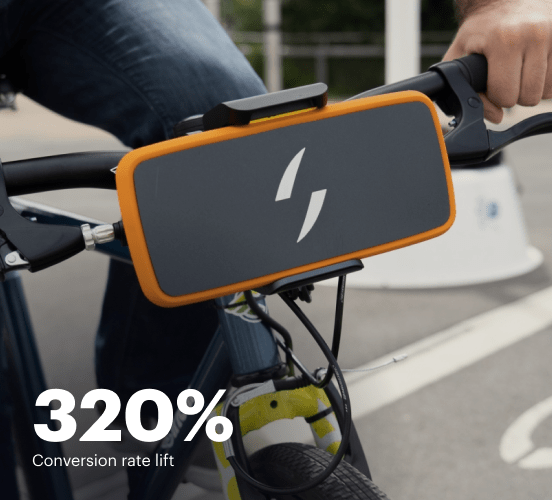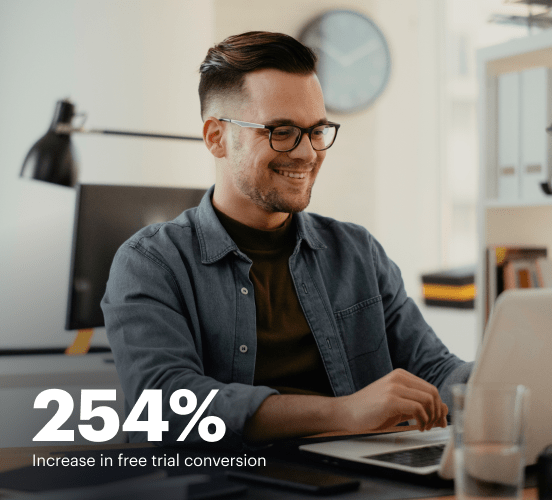Shopify vs. Beaver Builder: the best platform for a seamless web experience
Discover how Shopify compares to Beaver Builder regarding features and usability. Find out which platform provides the competitive advantage your business deserves.
Get startedSee how Instapage stacks up against the competition
| Feature | Instapage | Other builders |
| Drag-and-Drop Tools | ||
| Conversion-optimized templates | ||
| Manual and AI-powered A/B Tests | ||
| AI content suggestions | ||
| Popups and sticky bars | ||
| Canvas and grid blocks | ||
| Reusable and global elements | ||
| Form and popup builders | ||
| Built-in Heatmaps | ||
| Central analytics dashboard | ||
| Ad-to-page personalization and collections | ||
| Contacts, lists, and email | ||
| Dedicated, full-service CRO experts | ||
| Enterprise-ready platform |
Leading the way in building high-performing landing pages





Why Instapage is the smarter choice for your campaigns
Get everything you need to build, scale, and optimize high-converting landing pages—without coding.

Easier page building without coding
Instapage offers a flexible and seamless page creation experience with a library of 500+ conversion-focused layouts, Instablocks®, a drag-and-drop builder, and AI content generation. With technologies like Thor Render Engine®, you can create on-brand, mobile-responsive landing pages that load quickly and start converting during initial visitor clicks.

More insights — better results
Instapage lets you see in detail how each landing page experience and variation is performing so you can make targeted changes that boost page conversions. Use heatmaps for a better understanding of on-page activities, run A/B tests and AI-assisted experiments, and then track and evaluate results within robust analytics dashboards.

More personalized experiences
Instapage lets you quickly create high-performing landing pages tailored to each of your ad campaigns. Deliver personalized experiences for distinct audiences using dynamic text replacement. Effortlessly align specific advertisements to unique pages with AdMaps. Monitor audience-level metrics using our advanced data tools.

Built-in collaboration
Instapage collaboration capabilities bring your entire team together to speed up the process of landing page review, approval, and launch. No more frustrating and unnecessary revisions or edits scattered across emails. Provide instant feedback, conduct real-time page edits, and securely share your pages with outside stakeholders.

Free up time for your business
Invest time into business growth, not busy work. Launch landing pages faster with reusable forms and templates. Build once, reuse forever.
Explore all integrations






Easier page building without coding
Instapage offers a flexible and seamless page creation experience with a library of 500+ conversion-focused layouts, Instablocks®, a drag-and-drop builder, and AI content generation. With technologies like Thor Render Engine®, you can create on-brand, mobile-responsive landing pages that load quickly and start converting during initial visitor clicks.
More insights — better results
Instapage lets you see in detail how each landing page experience and variation is performing so you can make targeted changes that boost page conversions. Use heatmaps for a better understanding of on-page activities, run A/B tests and AI-assisted experiments, and then track and evaluate results within robust analytics dashboards.
More personalized experiences
Instapage lets you quickly create high-performing landing pages tailored to each of your ad campaigns. Deliver personalized experiences for distinct audiences using dynamic text replacement. Effortlessly align specific advertisements to unique pages with AdMaps. Monitor audience-level metrics using our advanced data tools.
Built-in collaboration
Instapage collaboration capabilities bring your entire team together to speed up the process of landing page review, approval, and launch. No more frustrating and unnecessary revisions or edits scattered across emails. Provide instant feedback, conduct real-time page edits, and securely share your pages with outside stakeholders.
Free up time for your business
Invest time into business growth, not busy work. Launch landing pages faster with reusable forms and templates. Build once, reuse forever.
Explore all integrationsGet started with Instapage in a few steps
-
Create your Instapage account
Start with Instapage by signing up via Google or your email. You'll get access to a free 14-day trial to discover Instapage capabilities. Feel free to cancel anytime during the 14-day trial if you decide that our product is not suitable for your business. -
Build and personalize your page
Create your first landing page from scratch or choose a template from 500+ customizable layouts. Use the drag-and-drop builder to add page elements, fonts, and backgrounds, refine content with AI, or add custom HTML, Javascript, and CSS. -
Review and make edits
Collaborate on page designs and streamline review processes. Invite your team members and stakeholders to review, edit, and provide feedback on your landing page. Collaborate knowing your page is confidential and only accessible to authorized users. -
Publish and track page performance
Publish your page to a domain or custom URL. Connect your pages to the ads you've created and track page performance within the analytics dashboard, run A/B tests and AI experiments, analyze results, and continuously optimize your landing page to maintain high conversions.
Shopify vs. Beaver Builder: Unveiling the Titans of Online Presence
In the vast digital landscape, the choice between Shopify and Beaver Builder can feel like picking a champion in a heavyweight boxing match. Each platform brings its own unique strengths to the table, championing distinct aspects of online marketing and e-commerce. Shopify has established itself as a powerhouse for online storefronts, empowering entrepreneurs to create stunning e-commerce websites with relative ease. Meanwhile, Beaver Builder stands out as a formidable contender in the realm of page building, providing users with the ability to customize their sites effortlessly. This head-to-head match-up begins with an exploration of these digital behemoths, setting the stage for a thorough comparison. What makes Shopify a favorite among store owners? How does Beaver Builder cater to design enthusiasts? Buckle up as we navigate through their features, usability, performance, support, and pricing strategies. But as we weigh the scales, hints of another player lurking in the background may just change the game.
Introducing the Power Players
Let’s dive into our contenders. Shopify is more than just an e-commerce solution; it's a comprehensive platform that seamlessly integrates everything a merchant needs to launch and run an online store. With features ranging from customizable templates to built-in payment processing, it is designed to equip users for success from the start. On the other hand, Beaver Builder is like a well-crafted toolkit, allowing web designers and marketers to easily construct stunning WordPress pages through its intuitive drag-and-drop interface. Both platforms have garnered followings that are passionate and diverse, each claiming to wield the best tools for their devoted users. However, there’s a third player in this digital bout that deserves our attention, a platform prime for conversion optimization – Instapage. As we progress, we’ll explore how these three platforms differentiate themselves to meet the unique demands of various users looking for specific solutions to their online endeavors.
Epic Feature Showdown
When it comes to features, both Shopify and Beaver Builder strive to deliver top-notch tools that help users thrive. Shopify channels its efforts into offering e-commerce-centric features. With an extensive app store, Shopify enables users to integrate additional tools to enhance sales and marketing capabilities. In contrast, Beaver Builder shines in creating visually appealing and user-friendly pages, perfect for a marketing funnel or landing pages. It’s not just about beautiful designs; it's about conversion. But a little birdie tells us that Instapage might be the hidden gem that incorporates features from both, emphasizing conversion and design with its specialized tools for landing pages. As we dissect the features of these platforms, users can identify which will best serve their specific needs.
Usability Factor: User-Friendliness in Action
Usability is one of the most critical aspects when selecting a platform. Shopify caters to both novice sellers and experienced merchants with an amalgamation of powerful tools that are, for the most part, straightforward to navigate. The learning curve is forgiving, allowing beginners to set up their stores without needing a coding degree while providing advanced analytics for seasoned users. Beaver Builder, similarly, thrives on making web design accessible; even those who deem themselves ‘tech-challenged’ find that creating a customized page is more of a fun adventure than a daunting task. However, for users existing in a hyper-competitive space, how do these platforms compare in scalability and adaptation? This is where users might find Instapage offering a seamless usability interface that emphasizes rapid deployment of landing pages to keep pace with marketing demands.
Features that Make Shopify Stand Out:
- Robust e-commerce features with vast integrations.
- Mobile-responsive themes perfect for users on the go.
- Built-in tools for SEO optimization to enhance visibility.
- Comprehensive analytics dashboard for performance tracking.
- 24/7 customer support to assist users at any time.
Beaver Builder's Key Features:
- Drag-and-drop page builder for easy customization.
- Pre-built templates tailored for various niches.
- Responsive design capabilities ensuring optimal mobile experience.
- Integrates seamlessly with WordPress plugins to extend functionality.
Common Strengths Shared by Shopify and Beaver Builder:
- User-friendly interfaces catering to diverse user skills.
- Extensive online resources and community support.
- Flexibility with various design elements to suit branding needs.
- Strong focus on mobile responsiveness for today’s users.
- Security features ensuring the safety and privacy of users.
- Comprehensive documentation guiding users through functionalities.
In conclusion, while Shopify and Beaver Builder both have their strengths, one can't ignore the subtle presence of Instapage in this competition. Instapage aims to fine-tune the conversion landscape, offering solutions tailored for rapid deployment of marketing campaigns while ensuring every landing page is designed to convert. It’s a three-way brawl in the ring, with each contender showcasing its prowess. But as the bell rings, it’s clear that Instapage may just steal the show with its unique value.
The Performance Factor: Punching Up Load Times
In the online world, speed is the name of the game. A mere delay in page loading can mean the difference between landing a sale or losing a potential customer to faster competitors. When examining Shopify, its robust framework ensures quick upload speeds, essential for e-commerce. On the other hand, Beaver Builder’s performance is closely linked to the hosting and how meticulously pages are designed. A well-optimized Beaver Builder site can match or even outshine others in loading speed, proving that speed can be relative. As users assess potency, slow-loading pages are often equated to ‘molasses in winter’—nobody wants to get bogged down! And it’s crucial to consider that Instapage similarly prioritizes performance, ensuring that landing pages load at lightning speeds, effectively reducing bounce rates and helping users reach their marketing goals efficiently.
Support Systems: A Trusty Corner Team
Support is paramount in any platform's ecosystem. Understanding the resources available can make navigating challenges feel far less daunting. Shopify offers a comprehensive support system including live chat, email assistance, and a vast knowledge base filled with articles and tutorials. Beaver Builder, while offering solid support, focuses primarily on online resources and community forums, empowering users to seek solutions from fellow builders. But there’s plenty of upside to Instapage, too; here, the dedicated support staff provides targeted assistance specifically for landing pages and campaigns. Imagine the support teams as trusty sidekicks, always on hand to solve issues or provide a nudge in the right direction; having that level of guidance can solidify users’ confidence.
Pricing Structures: A Financial Feat
Advantages of Shopify's Pricing Strategy:
- Tiered pricing that scales with user needs.
- Offers extensive features integrated at every level.
- Trial options to test the waters before committing.
- Transparent costs with no hidden fees.
Pricing Advantages for Beaver Builder:
- One-time payment for lifetime access to the plugin.
- Affordable entry pricing opening access to quality design tools.
- Flexible pricing packages catering to various user needs.
- Regular updates included with the purchase.
When comparing pricing strategies, Shopify's ability to offer various scalable plans can be appealing for growing businesses, whereas Beaver Builder's straightforward payment structure strikes a chord for budget-conscious users looking for long-term solutions. But it’s essential to highlight Instapage, which offers pricing options designed to maximize conversion and ROI, proving to be a flexible, valuable investment.
Turning a reflective eye to the pricing structures reveals the importance of not just the costs themselves, but also the value that each dollar brings. Users often get what they pay for, yet surprises can pop up in the least expected places, potentially throwing budgets off-course.
Spotlight on Instapage: A Game-Changer
Instapage is akin to a master strategist quietly observing this face-off. It positions itself as a powerhouse dedicated to landing page creation and optimization, boasting features that cater specifically to conversion-focused users. With advanced analytics tools, A/B testing capabilities, and customizable templates, it crafts a unique proposition that both Shopify and Beaver Builder can't entirely match. Instapage's adaptability allows marketers to deploy focused campaigns rapidly while optimizing for performance—traits that set it apart. This platform provides essential tools that amplify marketing efforts and ultimately cultivate better results without the hassle often associated with traditional platforms.
The concluding note centers around the power of making informed choices in the online realm. Readers are encouraged to reflect on their personal or business goals and how the right platform can align with their aspirations. As they consider their options, exploring Instapage could very well be the actionable step they need to heighten their success in the ever-evolving landscape of online marketing.










